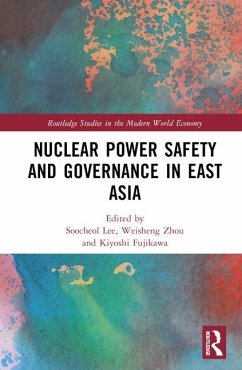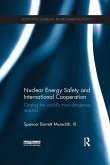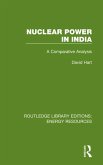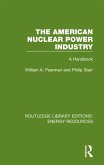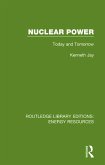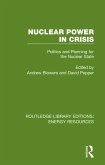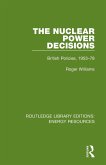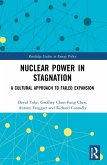Nuclear Power Safety and Governance in East Asia
Herausgeber: Lee, Soocheol; Fujikawa, Kiyoshi; Zhou, Weisheng
Nuclear Power Safety and Governance in East Asia
Herausgeber: Lee, Soocheol; Fujikawa, Kiyoshi; Zhou, Weisheng
- Gebundenes Buch
- Merkliste
- Auf die Merkliste
- Bewerten Bewerten
- Teilen
- Produkt teilen
- Produkterinnerung
- Produkterinnerung
Confronting the challenges of nuclear power governance, this book provides pathways to nuclear safety cooperation between countries in East Asia where regional cooperation is challenged by geopolitical tensions.
Andere Kunden interessierten sich auch für
![Nuclear Energy Safety and International Cooperation Nuclear Energy Safety and International Cooperation]() Spencer Meredith IIINuclear Energy Safety and International Cooperation61,99 €
Spencer Meredith IIINuclear Energy Safety and International Cooperation61,99 €![Nuclear Power in India Nuclear Power in India]() David HartNuclear Power in India49,99 €
David HartNuclear Power in India49,99 €![The American Nuclear Power Industry The American Nuclear Power Industry]() William A. PearmanThe American Nuclear Power Industry49,99 €
William A. PearmanThe American Nuclear Power Industry49,99 €![Nuclear Power Nuclear Power]() Kenneth JayNuclear Power49,99 €
Kenneth JayNuclear Power49,99 €![Nuclear Power in Crisis Nuclear Power in Crisis]() Nuclear Power in Crisis51,99 €
Nuclear Power in Crisis51,99 €![The Nuclear Power Decisions The Nuclear Power Decisions]() Roger WilliamsThe Nuclear Power Decisions51,99 €
Roger WilliamsThe Nuclear Power Decisions51,99 €![Nuclear Power in Stagnation Nuclear Power in Stagnation]() David TokeNuclear Power in Stagnation60,99 €
David TokeNuclear Power in Stagnation60,99 €-
-
-
Confronting the challenges of nuclear power governance, this book provides pathways to nuclear safety cooperation between countries in East Asia where regional cooperation is challenged by geopolitical tensions.
Hinweis: Dieser Artikel kann nur an eine deutsche Lieferadresse ausgeliefert werden.
Hinweis: Dieser Artikel kann nur an eine deutsche Lieferadresse ausgeliefert werden.
Produktdetails
- Produktdetails
- Verlag: Routledge
- Seitenzahl: 272
- Erscheinungstermin: 7. Dezember 2023
- Englisch
- Abmessung: 240mm x 161mm x 19mm
- Gewicht: 575g
- ISBN-13: 9781032596150
- ISBN-10: 1032596155
- Artikelnr.: 69030899
- Herstellerkennzeichnung
- Libri GmbH
- Europaallee 1
- 36244 Bad Hersfeld
- gpsr@libri.de
- Verlag: Routledge
- Seitenzahl: 272
- Erscheinungstermin: 7. Dezember 2023
- Englisch
- Abmessung: 240mm x 161mm x 19mm
- Gewicht: 575g
- ISBN-13: 9781032596150
- ISBN-10: 1032596155
- Artikelnr.: 69030899
- Herstellerkennzeichnung
- Libri GmbH
- Europaallee 1
- 36244 Bad Hersfeld
- gpsr@libri.de
Soocheol Lee is a Professor at the Faculty of Economics, Meijo University, in Japan. He graduated from Seoul National University and received his PhD at the Graduate School of Kyoto University. He had worked for the Federation of Korean Industry as a team leader of the Economic Research Department. He has written many books and papers on energy and environmental policy design and cooperation for sustainable low-carbon economy in East Asia. He was the Vice President of Asian Association of Environmental and Resource Economics, September 1, 2021, August 31, 2023. Weisheng Zhou is a Professor at the College of Policy Science, Ritsumeikan University, in Japan. He is a Foreign Fellow of the Engineering Academy of Japan. He graduated from Zhejiang University and received his PhD from the Graduate School of Kyoto University. He has served as a chief researcher and research consultant at the Research Institute of Innovative Technology for the Earth, a special professor at Osaka University. His books include East Asian Low-Carbon Community (Springer, 2021). Kiyoshi Fujikawa is a Professor at the Faculty of Economics, Aichi Gakuin University, in Japan. He graduated from Kobe University in Japan and received his PhD there. He had worked at the Department of Economics and Social Affairs in the United Nations as a statistician before teaching in Japan. He has made significant contributions to application of input-output analysis on environmental economics. And he was the President of Pan Pacific Association of Input-Output Studies.
Introduction
Part 1 Nuclear power risk and nuclear safety communication in East Asia
1. Cause classification and preventive countermeasures of nuclear reactor
accidents in China: Comparative analysis with those of Japan and South
Korea.
2. Radioactive material leakage impact on Japan, South Korea, and China in
the case of nuclear power plant accidents and spent fuel pool fires in this
region: Analysis using the HYSPLIT simulation model.
3. Comparative analysis of Chinese, Japanese and South Korean attitudes
toward nuclear safety in East Asia: Survey based on a survey of Tokyo,
Seoul, and Beijing residents.
Part 2 Nuclear policy and harmonization of nuclear safety standards in East
Asia
4. Nuclear policy and nuclear safety regulations in East Asia
5. State of harmonization of Western European nuclear safety standards and
results of its analysis
6. Barriers and challenges to harmonizing nuclear safety standards and
exchange of nuclear safety technology in East Asia
Part 3 Comparative analysis of nuclear regulation agency and building a
nuclear safety system in East Asia
7. Comparative analysis of nuclear regulatory agencies in East Asia from
the perspective of independence and transparency
8. Taiwan's denuclearization process and energy supply plan
Appendix: Independence of Taiwan's Nuclear Regulatory Agency
9. Building nuclear safety system in East Asia toward nuclear safety
society: Challenges to overcome segmented nuclear safety system.
Conclusion
Part 1 Nuclear power risk and nuclear safety communication in East Asia
1. Cause classification and preventive countermeasures of nuclear reactor
accidents in China: Comparative analysis with those of Japan and South
Korea.
2. Radioactive material leakage impact on Japan, South Korea, and China in
the case of nuclear power plant accidents and spent fuel pool fires in this
region: Analysis using the HYSPLIT simulation model.
3. Comparative analysis of Chinese, Japanese and South Korean attitudes
toward nuclear safety in East Asia: Survey based on a survey of Tokyo,
Seoul, and Beijing residents.
Part 2 Nuclear policy and harmonization of nuclear safety standards in East
Asia
4. Nuclear policy and nuclear safety regulations in East Asia
5. State of harmonization of Western European nuclear safety standards and
results of its analysis
6. Barriers and challenges to harmonizing nuclear safety standards and
exchange of nuclear safety technology in East Asia
Part 3 Comparative analysis of nuclear regulation agency and building a
nuclear safety system in East Asia
7. Comparative analysis of nuclear regulatory agencies in East Asia from
the perspective of independence and transparency
8. Taiwan's denuclearization process and energy supply plan
Appendix: Independence of Taiwan's Nuclear Regulatory Agency
9. Building nuclear safety system in East Asia toward nuclear safety
society: Challenges to overcome segmented nuclear safety system.
Conclusion
Introduction
Part 1 Nuclear power risk and nuclear safety communication in East Asia
1. Cause classification and preventive countermeasures of nuclear reactor
accidents in China: Comparative analysis with those of Japan and South
Korea.
2. Radioactive material leakage impact on Japan, South Korea, and China in
the case of nuclear power plant accidents and spent fuel pool fires in this
region: Analysis using the HYSPLIT simulation model.
3. Comparative analysis of Chinese, Japanese and South Korean attitudes
toward nuclear safety in East Asia: Survey based on a survey of Tokyo,
Seoul, and Beijing residents.
Part 2 Nuclear policy and harmonization of nuclear safety standards in East
Asia
4. Nuclear policy and nuclear safety regulations in East Asia
5. State of harmonization of Western European nuclear safety standards and
results of its analysis
6. Barriers and challenges to harmonizing nuclear safety standards and
exchange of nuclear safety technology in East Asia
Part 3 Comparative analysis of nuclear regulation agency and building a
nuclear safety system in East Asia
7. Comparative analysis of nuclear regulatory agencies in East Asia from
the perspective of independence and transparency
8. Taiwan's denuclearization process and energy supply plan
Appendix: Independence of Taiwan's Nuclear Regulatory Agency
9. Building nuclear safety system in East Asia toward nuclear safety
society: Challenges to overcome segmented nuclear safety system.
Conclusion
Part 1 Nuclear power risk and nuclear safety communication in East Asia
1. Cause classification and preventive countermeasures of nuclear reactor
accidents in China: Comparative analysis with those of Japan and South
Korea.
2. Radioactive material leakage impact on Japan, South Korea, and China in
the case of nuclear power plant accidents and spent fuel pool fires in this
region: Analysis using the HYSPLIT simulation model.
3. Comparative analysis of Chinese, Japanese and South Korean attitudes
toward nuclear safety in East Asia: Survey based on a survey of Tokyo,
Seoul, and Beijing residents.
Part 2 Nuclear policy and harmonization of nuclear safety standards in East
Asia
4. Nuclear policy and nuclear safety regulations in East Asia
5. State of harmonization of Western European nuclear safety standards and
results of its analysis
6. Barriers and challenges to harmonizing nuclear safety standards and
exchange of nuclear safety technology in East Asia
Part 3 Comparative analysis of nuclear regulation agency and building a
nuclear safety system in East Asia
7. Comparative analysis of nuclear regulatory agencies in East Asia from
the perspective of independence and transparency
8. Taiwan's denuclearization process and energy supply plan
Appendix: Independence of Taiwan's Nuclear Regulatory Agency
9. Building nuclear safety system in East Asia toward nuclear safety
society: Challenges to overcome segmented nuclear safety system.
Conclusion

